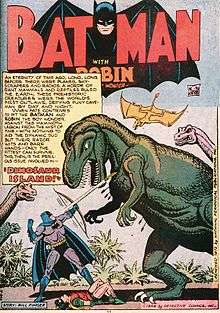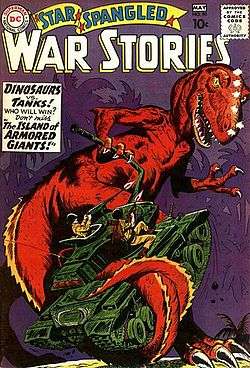Dinosaur Island
| Dinosaur Island | |
|---|---|
|
The first appearance of Dinosaur Island, from Star Spangled War Stories #90 | |
| Race(s) | Dinosaurs |
| Notable locations | South Pacific |
| First appearance | Star Spangled War Stories #90 (April–May 1960) |
| Publisher | DC Comics |
Dinosaur Island is an island that has appeared in various comic book series published by DC Comics.
Publication history
The first Dinosaur Island appeared in only one issue, Batman #35, from June 1946. The story by Bill Finger and Bob Kane, involved a "Dinosaur Island" amusement park that contained realistic looking and functioning robotic dinosaurs.
The second and definitive version of Dinosaur Island first appeared in the Spring 1960 issue of Star-Spangled War Stories #90. Created by Robert Kanigher and featuring early art from Ross Andru, this began an ongoing feature known as the The War That Time Forgot. Located in the South Pacific of DC's main shared universe, it is an island populated by living dinosaurs and other various prehistoric creatures. Most of these dinosaurs were much larger than their real life counterparts, as a Pteranodon was big enough to be able to tear apart a jet, while a Brontosaurus would be big enough to overturn an aircraft carrier. The stories were set in the 1940s during World War II, and periodically American and Japanese soldiers would stumble upon the island during battle encountering the creatures there. After its debut in Star Spangled War Stories #90, the feature would return in #92 and was an ongoing series until #137 in 1968. Afterwards the feature would appear sporadically in the pages of G.I. Combat, Weird War Tales, and other DC comic books.
Fictional history
First Dinosaur Island

The First Dinosaur Island is a newly constructed amusement park run by Murray Wilson Hunt. It is where Batman agrees to be part of a mock big-game hunt held by Mr. Breach. During the hunt, Murray is knocked out by Stephen Chase and takes control of Dinosaur Island in order to have the mechanical dinosaurs and cavemen attack Batman. Eventually, Batman and Robin were able to turn the tides on Mr. Breach and capture Stephen Chase. Afterwards, Batman gains a mechanical Tyrannosaurus as a trophy and has it placed in the Batcave.[1]
Second Dinosaur Island

Dinosaur Island seems to have first been discovered by Enemy Ace in 1927 when he flew Bat Lash, Biff Bradley, General Joseph Stilwell, and "Chop-Chop" (presumably the father of the Blackhawks member) to the island on a mission for Chiang Kai-shek. The island had long been a legend to the Chinese people (known as Dragon Island at the time) and was believed to hold the mystical Swords of Fan. During this mission, the adventurers encounter Vandal Savage and Miss Fear, in addition to the dangerous dinosaurs. This tale appears in the Guns of the Dragon mini-series.
During World War II, several United States submarines seemingly disappear after encountering an area of seismic disturbances. Marines land on a nearby island hoping to find survivors, but instead find that the earthquakes has awakened the remote island's resident dinosaur population. The prehistoric beasts had been preserved via suspended animation for centuries. With their weapons essentially useless, the squad of Marines barely escapes to tell the tale.
Despite the presence of dinosaurs, the U.S. government consider the island a valuable strategic location in its war against Japan. Several expeditions and operations take place at the island. The island is also used as a proving ground for the automated soldiers designated G.I. Robot, which prove to be no match for the dinosaurs' ferocious might. The Creature Commandos, the Flying Boots, and the original Suicide Squad all take part in missions on the island during World War II.
Post-War expeditions have theorized that the island exists in a state of temporal flux. Black Canary of the Birds of Prey lands on the island in modern times only to find it still inhabited by Japanese soldiers who are keeping Gunner and Sarge of "The Losers" in a P.O.W. camp.
The Suicide Squad series reveals that a post-War mission to the island by Sgt. Rock (allegedly) and Bulldozer explains why they haven't aged as much since World War II due to temporal fluctuations. The veracity of this story may be in dispute, as Bulldozer later cryptically announces that Sgt. Rock died in World War II.
In 2008, the Island was featured in the twelve-part series The War That Time Forgot.[2]
In 2016, Superman, his son Superboy, and Krypto were transported to the Island where they fought dinosaurs and found the remains of the Losers.
Other versions
DC: The New Frontier
Writer/artist Darwyn Cooke uses the island in his out-of-continuity series DC: The New Frontier, where he connects the island with the dawn of the Silver Age. In this series, the island is portrayed as the main antagonist, a sentient being called the Centre which has existed on the Earth since before the dawn of the human race. Feeling threatened by humanity's development of nuclear weapons, the Centre decides to end all life on Earth. In New Frontier, the Centre is portrayed as a living island with the ability to hover over great distances and spawn grotesque mutant dinosaurs to attack or defend itself.
In other media
Television
- Dinosaur Island is featured in the Batman: The Brave and the Bold episode "Terror on Dinosaur Island". Gorilla Grodd and his followers used it as the base for their headquarters. Grodd comments that the Bahamas, West Indies, and Florida are within a 500-mile radius of Dinosaur Island. The island is also featured in the team-up with the Challengers of the Unknown in "Revenge of the Reach." In "Four Star Spectacular," Dinosaur Island appeared where Creature Commandos teamed up with Batman to thwart Ultra-Humanite when he plans to build a mind-controlled dinosaur army. After Ultra-Humanite was defeated, the Creature Commandos destroy Lt. Matthew Shrieve's footage of Dinosaur Island to keep the place a secret.
Film

- The Centre is featured as the main antagonist in Justice League: The New Frontier voiced by Keith David. This version is a monstrous creature born from the Earth that has the appearance of a floating island. An organic sentient being observed the evolution of dinosaurs, the meteor shower and the evolution of humans. It saw humans as a threat to the existence of other species and took some and settled in the Pacific. Over the centuries, it gained a reputation as an omnipresent spirit with no beginning nor end. Different cultures describe the same legend, the coming of an ominous, omnipotent presence and great suffering. The famous children's author, Theodore Smiesel was overcome by the Centre's telepathy and wrote "The Last Story" describing the Centre. After the book's completion, Smiesel committed suicide. After it rose in 1957, there was a steady rise in the number of related incidents-mass delusions, people hearing voices in their heads and violent acts. It came across Paradise Island and wreaked havoc on the Amazons. Wonder Woman was able to escape and warn Superman before the Centre arrived offshore. A collective of government officials and super heroes formed a multi-faceted plan to defeat the Centre. While it was distracted by explosive payloads from outside and within, the Flash (Barry Allen) would expose it piece by piece with matter shrinking technology created by Ray Palmer. It sensed its end and attempted to make a suicide run at Cape Canaveral. Green Lantern intervened and used its power to encapsulate the Centre and hurled it into space where it imploded.
See also
- Savage Land
- Skartaris
- Dinosaur Island (1994 film)
- Dinosaur Island (2002 film)
- The Land That Time Forgot, also known as Dinosaur Island
References
- ↑ Batman #35
- ↑ "GCD:: The War That Time Forgot". Comics.org. Retrieved 21 January 2014.
